Chapter 1. Learning to Dive into Primary Research Articles
Introduction
Learning to Dive into Primary Research Articles
Introduction
You've been asked to evaluate a primary research article. Where can you find the message, the bottom line, the discovery? Where should you begin? Although it may be the first time you've found yourself peering through the pages of a primary research article, it certainly won't be the last. Reading the scientific literature can feel like a daunting task at first. The titles might use unfamiliar terms, you likely do not know the authors, and the abstract may be the densest prose you have ever read-
We define primary literature as the body of published work in academic journals containing peer-
Here we provide you with a guide to reading a primary research article. This guide begins by giving you an up-
Overview: What is the structure of a primary research article?
Title and Authors
All articles will have a title and one or more authors. Did you select this article based on the title? Is the title eye-
Notice that there is an order to the authors' names. There are many conventions for ordering the names of authors, and different labs use different conventions. One common practice is that the first author listed is the person who performed most of the experimental work presented in the article, and this person also wrote the bulk of the article. The last author is often the person whose lab the work was performed in, and this person may have been the "brains" behind the project who developed the experiments and ideas presented. The middle authors typically made significant contributions to the experiments in the article, but they did less work than the first author and likely contributed less to the writing of the article. Also notice that information about the work location of each author is provided. Depending on the number of authors and the locations of their laboratories, you may gain a sense of how collaborative and international the scientific process is.
Abstract
Below the authors' names, most primary research articles include an abstract. The abstract is a brief summary of the article. Most people choose which articles they would like to read based on the information provided in the abstract. The abstract typically includes the following information:
- why the research was done,
- how the research was done,
- what the experiments showed, and
- what the results of the experiments mean.
That is a lot of information, and you may find the abstract very dense and difficult to read. It is perfectly reasonable to read the abstract initially to select the article, but do not expect to understand it fully until after you have read the article in its entirety.
Body of the Article
1. Introduction: Provides the background information needed to understand the importance of the study and why the experiments were conducted. It introduces the question or hypothesis. The introduction starts very broadly and ends with the specific research questions addressed in the article.
2. Materials and Methods (or Experimental Procedures): Explains the tools used and how the experiments were carried out. Enough detail is included so that other scientists reading this article can evaluate the experiments and also reproduce the experiments in their own labs.
3. Results: Presents and explains what was discovered in the experiments. The results section often includes several figures or tables that illustrate the findings.
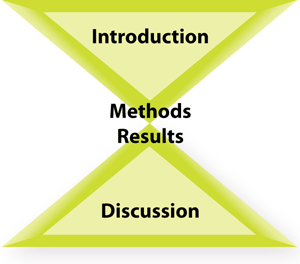
4. Discussion: Interprets the results of the study, placing them into a broader context of what is already known. It also includes speculation about why the results were obtained and what the results mean. Future experiments and speculation are often included. The Discussion section is a mirror image of the Introduction section: It starts by answering the specific research question(s) and ends broadly (Figure 1).
Many journals will use this overall format, and the sections are often labeled. Of course, articles from different journals can be organized differently. For example, sometimes the Materials and Methods section is at the end of the article, or occasionally the Results and Discussion sections are combined. Sometimes the individual sections are not labeled at all. Regardless of the organization of the particular article you are reading, all articles will contain the information that is found in these sections, and the overall content of the article will resemble an hourglass with broad to specific topics in the Introduction section, specific information in the Materials and Methods section and the Results section, and specific to broad concepts in the Discussion section. Before you begin to read an article, scan it to identify how it is structured. Once you have identified the structure of the article you are reading, you will quickly know where to look for the why, how, and what of the article.
Acknowledgments
The Acknowledgments section is generally at the end of the article just before the references. It is used to recognize individuals who have contributed to the experiments or to the writing of the article, but whose work does not constitute authorship. These people may have contributed reagents or helped review the manuscript. The Acknowledgments section is also where the authors recognize the source(s) of funding that financially supported the project.
References
The References section is typically at the very end of the article and is used to describe sources of information that were specifically cited in the text of the article. It is typically not a comprehensive bibliography of every source of information used by the authors, however. Each journal requires that the citations be shown using a specific format, both within the text and within the References section. Specific citation formats often differ from one journal to the next.
Three Strategies for Understanding a Primary Research Article
After you have identified the overall structure of a given article, we recommend that you read it using three different approaches to facilitate your understanding. Here we'll walk you through how to use three distinct, but complementary, strategies to read the article. The first strategy, called "the scan," allows you to gain a general idea of what the article is about and obtain background knowledge about the article. Using the second strategy, called "the thorough read," you will gain a deeper understanding of the article's contents as you go through the article line by line and look up the terms and techniques employed by the authors. The third strategy, called "the integration and analysis," helps you put together the why, how, and what of the article and allows you to see the "big picture." Once you use the first strategy to scan an article that interests you, you can use the second and third strategies to see the "big picture," absorb what was done, and determine the significance. Here we'll use a primary research article published by Fan, C., Liu, M., and Wang, Q. in 2003 in the Journal of Biological Chemistry (issue 278, pages 8780-
1.Fan, C., Liu, M. & Wang, Q. Functional analysis of TBX5 missense mutations associated with Holt-
The First Strategy: The Scan
The first strategy is focused on obtaining background knowledge and an overall sense of what the article is about. Start by reading the Title and Abstract sections of the article. Can you identify the general research area that the article addresses? If you are not familiar with the area of the research at all, now is a good time to consult a textbook or a review article so that you can familiarize yourself with the topic. If you have some familiarity with the field, review in your mind what you already know. Taking the time to review what you already know will allow you to better integrate the findings in the article with your previous knowledge, which can be very rewarding.
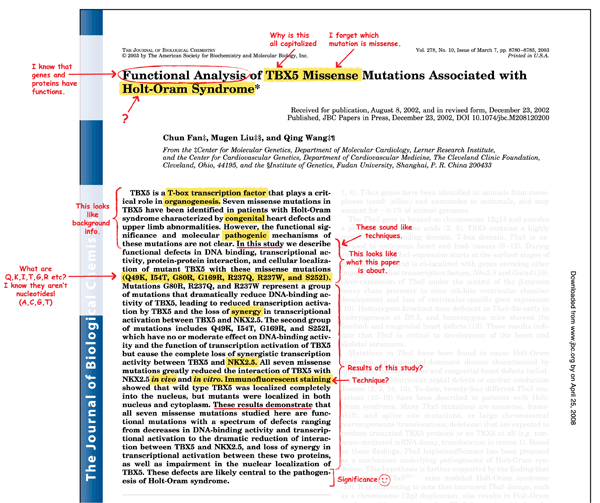
After you have reviewed the general research topic, we recommend that you read the Abstract line by line, not for understanding but to generate a list of terms. Your list should include terms that are unknown to you or terms that describe molecules, techniques, or nomenclature. Look up these terms using a textbook or a reliable website, such as Scitable.com.
After you have tackled the Abstract, we recommend reading the Introduction section and then skimming the figures and tables. After completing the first strategy and scanning the article during your first read, you probably will not understand everything that you have read, but you should be able to answer the following questions:
- What is the importance of the study? (Likely in the Introduction section.)
- What is the research question or hypothesis? (Likely toward the end of the Introduction section.)
- "What techniques did the authors use? (Likely in the figure and table legends.)
Research on teaching and learning shows that active learning-
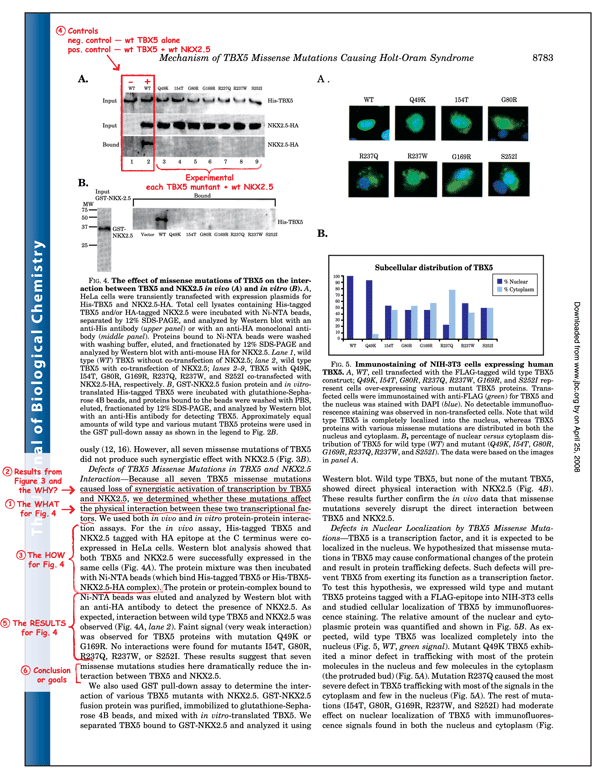
2.National Research Council. How People Learn: Brain, Mind, Experience, and School. Washington, DC: National Academy Press, 2000
The Scan of the Fan et al. Article
Depending on your background knowledge, you may have a number of different responses to the Title and Abstract sections of the Fan et al. article. Let's look at how one student might respond to the Title and the Abstract. This student highlighted terms she didn't know, noted the overall organization of the key structural elements in the Abstract, and made comments to connect ideas (Figure 2). She then looked up the terms she didn't understand. For example, Holt-
Acknowledgments
The student then answered the set of three questions related to the first strategy:
- Importance? After reading the Introduction section, the student concluded that the importance of this research was to understand what causes Holt-
Oram syndrome. - Research Question/Hypothesis? At the end of the third paragraph of the Introduction section, the student identified the research question: "It remains to be determined whether these Tbx5 missense mutations are functional mutations, and if they are, what are the molecular pathogenic mechanisms by which these mutations act."
- Techniques Used? The student identified the following techniques from the figure legends: EMSA and silver-
stained protein gel (Fan et al., Figure 2), transcriptional activation assay and Western blot (Fan et al., Figure 3), protein- protein interaction assay and GST pull- down assay (description of Fan et al., Figure 4 in the Results section), and immunostaining (Fan et al., Figure 5).
The Second Strategy: A Thorough Read
The second strategy is focused on obtaining a thorough understanding of what the article is about. Before you begin the second strategy, make sure that you have patience and time to methodically go through the article line by line, looking up terms, phrases, and techniques as you go. You have already read and looked up terms in the Abstract section using the first strategy, so you will begin the second strategy equipped with general knowledge about the information the article will contain. Begin the second strategy with the Introduction section.
Introduction
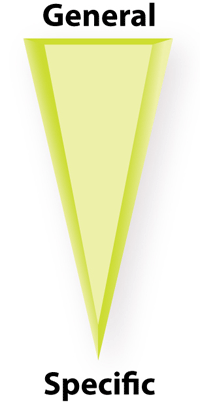
The purposes of the Introduction section are to provide background information and to frame the question or questions the authors seek to answer. If the work is hypothesis-
The Thorough Read of Fan et al.: The Introduction
- Paragraph one describes T box transcription factors in general.
- Paragraph two specifically describes the TBX5 transcription factor and its role in gene regulation during development.
- Paragraph three describes the seven TBX5 mutations and presents the research question for this article.
- Paragraph four describes previous biochemical work showing that TBX5 interacts with other proteins and target genes.
- Paragraph five describes the specific target genes for TBX5.
- Paragraph six summarizes what was found in this study.
Materials and Methods/Experimental Procedures
After you've read the Introduction section, skip the Materials and Methods section for now. In the Fan et al. article, the Experimental Procedures section follows the Introduction section. It is increasingly common for this section to be located at the end of an article, relegated to the figure legends, or even available only online as a Supplementary Material section. This section tells you that information provided in the Materials and Methods section is often not considered critical for understanding the article. Journal space limits are becoming increasingly tight, and the Materials and Methods sections are becoming more condensed. As a result, the authors often refer the reader to previously published articles that carried out related experiments.
That is not to say that the Materials and Methods section is not valuable. For example, you may want to refer to the Materials and Methods section to gain a better understanding of how a particular experiment was performed. An example is provided in the following page. Also, if you wanted to repeat the experiments or perform related experiments, you would read and follow the instructions very carefully; however, for most readers, this step is not necessary.
Results
Remember that the Results section of a primary research article is the reason the article was written in the first place. The investigators used the scientific method to ask a question, formulate a hypothesis, and make predictions presented to the reader at the end of the Introduction section. In addition, the data provided in the Results section represent the experimental findings. Remember that the Results section only presents the results of the experiments; it is not a place where the authors usually explain or discuss the significance of the data, which is saved for the Discussion section. The Results section typically includes all or most of the figures and tables as well as text that will help the reader to connect ideas, experiments, and data to one another. The text in the Results section will also draw the reader's attention to specific ideas or note similarities, differences, or trends in the findings. If you are familiar with the scientific field, you may do most of your "reading" of articles by analyzing the figures and figure legends. The text of the Results section, however, does contain information meant to help the reader understand what was discovered and to establish connections between the different experiments.
For each figure shown in the Results section, you should be able to answer the following questions:
- What experiment was done?
- Why was each experiment done?
- How was each experiment done?
- What were the controls for each experiment?
- What does each experiment show?
- How do these results contribute to the overall goals of the authors?
Notably, the answers to these questions may be found in the figure legends, the data, or the text of the Results section.
The Thorough Read of Fan et al.: The Results (focus on Figure 4A)
A primary research article will contain between one and several individual experiments that complement one another to address the author's hypothesis, which is typically related to some natural phenomenon. In the TBX5 article, the authors set out to better understand how seven known TBX5 mutations are associated with an altered phenotype and lead to human disease. The TBX5 authors present their results in five figures.
Figure 3 shows an example of how a student was able to answer all six of the questions above for Figure 4A of Fan et al. during her thorough read of the article.

If you wanted to repeat the experiments shown in Figure 4A of Fan et al., you could refer to the Experimental Procedures section to learn more about the steps carried out and the buffers, antibodies, and other reagents used in the experiments.
Discussion
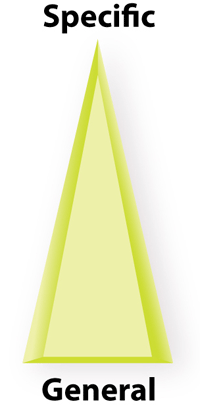
The Discussion section should flow from the specific to the general (Figure 5). Ideally, the Discussion follows the organization below:
- The authors answer the question or questions that were the focus of the study.
- The authors present the lines of evidence that support their conclusions.
- The authors speculate about why they observed the results they discovered.
- The authors relate their findings to what was previously known and discuss how their work furthers the body of knowledge in their field.
- The authors suggest future experiments.
Reading the Discussion section can be challenging. By design, the Discussion section contains speculation, and for readers unfamiliar with the field, it can be difficult to separate facts from speculation. Remember that data can only suggest; they do not prove. Another challenge is that the authors may intentionally or unintentionally have a bias, and they may try to lead you toward one way of thinking about the data. Also, some authors will explore side branches of the research topic, taking a novice reader off track.
You can avoid these pitfalls. Before reading the Discussion, review the figures and your answers to each of the six questions posed in the Results section. If you were the author, what would you address in the Discussion? After you have answered this question for yourself, you are ready to jump into the Discussion. Read the Discussion carefully, but remember that much of it is based on speculation or opinion.
The Thorough Read of Fan et al.: The Discussion
Notice that the Discussion section of Fan et al. begins with a general statement about the overall findings of the article: that the TBX5 mutations examined show a number of defects that affect TBX5 function. Because the mutations studied are found in people with Holt-
For the remainder of the Discussion section, the authors use language to present their data in the best light possible and to highlight the points they want to make. Some points to notice:
- In the second paragraph, the authors discuss how their work complements and furthers what is already known about these TBX5 mutations, and the authors use the word "surprisingly," which places a value judgment (bias) on the information that follows.
- In the third paragraph, the word "dramatically" is used, and this word choice is subjective and open to interpretation. The authors are influencing you to think in a particular way.
- The fourth paragraph suggests a future experiment focused on a structure-
function analysis between TBX5 and NKX2.5. - In the fifth paragraph, the authors acknowledge that they are speculating. Be aware that many authors will not use the words "we speculate."
The Third Strategy: Integration and Analysis
The third strategy is focused on obtaining the "big picture" about the primary research article. Using the first strategy, you gained a general sense of what the article was about and the authors' goals. Using the second strategy, you meticulously went through the article line by-
Some questions to consider when using the third strategy include:
- How does each experiment flow into the next experiment?
- Do the authors show bias?
- Do you agree with the author's interpretation of the data?
- What could the authors have done better?
- What do you think the next experiments should be?
The Integration and Analysis of Fan et al.
The first question above could be answered by looking at the figures from the Fan et al. article. In Figure 1 of Fan et al., the authors present the seven TBX5 missense mutations that are the focal point of this study. Because TBX5 is a transcription factor, it binds to DNA, and in Figure 2 of Fan et al. the authors examine DNA binding by the seven TBX5 mutants. Another function of transcription factors is activation of transcription. The reporter assay in Figure 3 of Fan et al. shows transcriptional activation by the TBX5 mutants. This figure also shows the necessary synergy between TBX5 and NKX2.5 for full transcriptional activation. Because TBX5 missense mutations show the lack of synergy with NKX2.5, the interactions between TBX5 mutants and NKX2.5 are studied in the experiments shown in Figure 4 of Fan et al. Transcription factors must be localized to the nucleus for function, and the authors use immunostaining to show abnormal cellular localization of TBX5 mutants.
To address bias in question 2, consider the words the authors use to describe the results, the length of the discussion about the various results, and the experiments shown and their order. For example, does the author's phrase "dramatically reduced binding of TBX5 to the DNA target" show bias? Does the length of the discussion about TBX5 missense mutations binding to DNA compared with the length of the discussion about the results from the transcriptional activation assay suggest something about what the authors find important? How would the authors' TBX5 story be different had the immunostaining experiment in Figure 5 of Fan et al. been shown earlier in the paper?
You may address the points raised in questions 3 and 4 together. For example, in Figure 5 of Fan et al. the authors speculate that the distribution of the mutant TBX5 proteins is due to defects in trafficking. Is there any evidence for this speculation? Is there another interpretation? When critically evaluating the data, it may be helpful to refer to the Materials and Methods section. If you do, you learn that a plasmid containing the Tbx5-
Looking at your answers to questions 3 and 4, what experiments do you think should be done next? Should the authors repeat their experiments in cells from patients with Holt-
Searching for an Article in Databases
Here we'll discuss some helpful strategies for searching for a primary research article. The approach you take when choosing a primary research article will depend on your purpose. Familiarize yourself with two search engines commonly used for finding articles in the sciences: PubMed at http:/
SUMMARY
Our hope is that whether you are new to the scientific literature or not, you will have gained confidence in your ability to dive into the primary literature. We have also shown you what to expect in terms of the structure of a primary research article, and we have provided a three-
Quiz
Question 1.1
1. Primary literature refers to published works that contain
| A. |
| B. |
| C. |
| D. |
Question 1.2
2. The significance of the study can generally be found in the ______________ section and the significance of the experimental data is found in the __________section.
| A. |
| B. |
| C. |
| D. |
Question 1.3
3. The purpose of initially scanning an article is to
| A. |
| B. |
| C. |
| D. |
Question 1.4
4. Typically, the Results section of a scientific paper contains all of the following except
| A. |
| B. |
| C. |
| D. |
Question 1.5
5. During the "Thorough Read" of a primary literature article, it is suggested that you skip the Materials and Methods section because
| A. |
| B. |
| C. |
| D. |
Question 1.6
6. It is recommended that you read a primary research article three times: first, "the scan"; second, "the thorough read"; and finally, "the integration and analysis." The purpose of the third reading of the paper is to
| A. |
| B. |
| C. |
| D. |